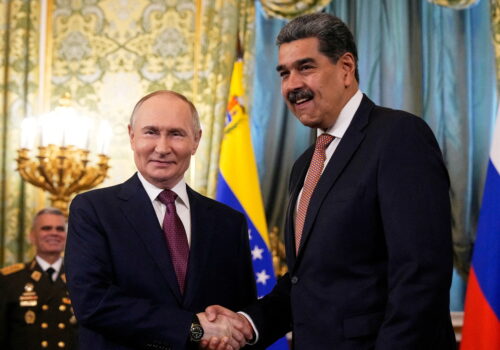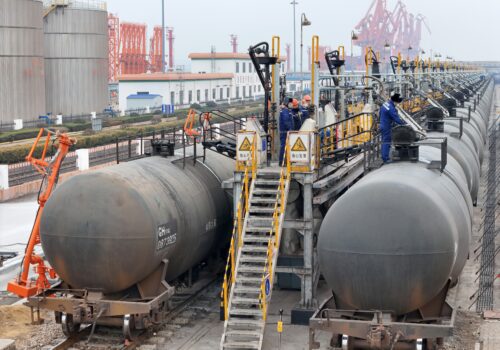As the US military buildup increases near the shores of Venezuela, the United States could consider a measure to pressure Nicolás Maduro’s government without resorting to force: restricting its access to dollar-pegged stablecoins. Reports suggest that the Venezuelan government has been receiving oil payments in the stablecoin USDT since 2024—undermining the sanctions the Trump administration placed on Venezuela’s state-owned oil company and central bank in 2019. This method resembles sanctions evasion schemes used by other heavily sanctioned states, including Russia, Iran, and North Korea, and it merits a strong and coordinated US policy response.
Crypto adoption is Venezuela’s response to US sanctions
In recent years, the United States has imposed sanctions on Venezuela in response to the Maduro government’s repression of opposition groups and “subversion of democracy.” Much of this US economic pressure has come since 2017, when the Trump administration issued a series of executive orders that it then expanded. In 2019, the United States enacted full blocking financial sanctions against PDVSA (the state-owned oil company Petróleos de Venezuela, S.A.) and the Central Bank of Venezuela.
Venezuela’s oil sector was particularly exposed, given its complete reliance on PDVSA—a company already weakened by aging infrastructure and chronic underinvestment. This overreliance on PDVSA left both the energy sector and Venezuela’s broader financial system acutely vulnerable to financial sanctions.
This year, the Trump administration has increased economic pressure further, imposing a 25 percent tariff on buyers of Venezuelan oil in March. However, the Maduro government has not yielded to US economic pressure by ceding power. Instead, it has adopted sanctions evasion methods developed by China, Russia, Iran, and North Korea—a group for which my colleague Kimberly Donovan and I coined the term “Axis of Evasion” due to their shared tactics and cooperation in circumventing Western sanctions.
Like Iran and Russia, Venezuela needed to receive oil payments from China outside the reach of Western financial oversight. Transacting with cryptocurrencies is one such evasion method, which North Korea, for example, has used in the past to launder the proceeds of cybercrime. Last year, Russia softened its restrictive stance on cryptocurrencies by allowing companies to use them in cross-border trade. Reports from this year indicate that Russia has been receiving oil payments from Chinese and Indian customers in Bitcoin and other cryptocurrencies, with transaction volumes reaching tens of millions of dollars.
The Venezuelan government has spent several years experimenting with cryptocurrencies, most notably with the launch of the state-backed petro (PTR), which was launched in 2018 and collapsed in 2024. As US sanctions on Venezuela intensified in 2019 and the years since, the Maduro regime grew increasingly interested in leveraging digital assets to facilitate oil transactions—leading to US Department of Justice indictments against individuals brokering these deals. Over the past year, Caracas has turned to USDT, a dollar-pegged stablecoin issued by the offshore company Tether, as an alternative vehicle for international payments.
Tether has previously faced scrutiny over its alleged involvement in illicit finance and money laundering. Notably, Tether has also worked with the US Department of Justice in an investigation that led to the dismantling of the online infrastructure supporting Garantex, a sanctioned cryptocurrency exchange implicated in facilitating Russia sanctions evasion and money laundering by transnational criminal organizations. By 2024, Tether had also frozen forty-one wallets that were using USDT to evade sanctions on Venezuela’s oil.
By the end of first quarter of 2024, PDVSA began requiring new clients to use digital wallets and make payments in USDT for spot oil deals. Subsequently, Venezuelan authorities enabled a limited number of banks and exchange houses to offer USDT to private companies, in exchange for bolívars. In July alone, an estimated $119 million in cryptocurrencies were sold to the private sector. This shift marked the growing use of cryptocurrencies, predominantly USDT, as a substitute for physical US dollars in domestic financial flows. While crypto still represents only a small share of total oil trade by value, it plays an outsized strategic role by offering sanctioned regimes a parallel payment channel outside traditional banking.
Sanctioned oil trade schemes between China and Venezuela
Similar to other “Axis of Evasion” countries, Venezuela transports oil to China via shadow fleet tankers—sometimes called “ghost ships”—employing at-sea evasion tactics such as turning off trackers during ship-to-ship transfers and rebranding the Venezuelan crude oil as Malaysian. By 2020, official Chinese imports of Venezuelan oil dropped to zero, while Malaysian oil imports surged to a sixteen-year high.
Like Iran and Russia, most of Venezuela’s oil is refined by small independent Chinese refineries known as teapots, primarily located in Shandong province. Although China officially halted imports of Venezuelan crude after sanctions in 2019, China remains the primary destination for Venezuelan crude exports. In September, approximately 84 percent of Venezuela’s exported oil went there, either directly or indirectly. Thus, it is widely reported that Venezuelan oil goes to China, and that Venezuela ends up with USDT. What remains unknown—and needs investigation—is the payment chain that connects these two facts.
New Chinese investments in Venezuela’s oil sector
Venezuela has historically had investments from Chinese companies in its oil sector. While China National Petroleum Corporation halted operations in Venezuela in 2019 due to the risk of US secondary sanctions, reports from August indicate that the smaller China Concord Resources Corp (CCRC) is investing one billion dollars in two Venezuelan oil fields. In May 2024, CCRC signed a twenty-year shared production agreement, aiming to produce sixty thousand barrels per day by the end of 2026. Under this deal, lighter crude will be supplied to PDVSA, while heavier crude will be exported to China.
This development carries two major implications. First, it challenges the strategic framework through which the United States has traditionally approached sanctions on Venezuela. Washington has long operated under the assumption that escalating sanctions on Venezuela’s oil sector would deter foreign companies from operating there due to the risk of secondary sanctions—and, until now, that assumption has largely held. A twenty-year production agreement with a smaller Chinese firm, however, suggests that Beijing may no longer be willing to adjust its trade and investment decisions in Venezuela according to US sanctions.
Second, if CCRC can indeed raise production to the stated levels and deliver half of the output to Venezuelan authorities, restricting the Maduro regime’s access to cryptocurrencies may become the only remaining lever to curb its oil revenues. That said, CCRC has no prior drilling experience, underscoring the need for caution and close monitoring of whether it can realistically meet its production targets.
What should the US do next
Recent reporting by Reuters and the New York Times indicates that sanctioned entities—including PDVSA—are now using crypto to receive oil payments. To ensure the Maduro regime is not using cryptocurrencies to undermine the Trump administration’s sanctions strategy, the US government, in coordination with partners and allies, should build out the intelligence picture regarding Venezuela’s use of stablecoins and other digital assets to evade sanctions. After identifying the key actors and wallets involved, the government can use targeted sanctions and law enforcement actions, consistent with past actions against Venezuelan oil-trade–related schemes. It should also share relevant information with private-sector partners, particularly stablecoin issuers and exchanges. The government should then request their cooperation on freezing wallets linked to sanctioned individuals, which issuers and exchanges have done before.
Understanding how to counter sanctions evasion through cryptocurrencies is critical—not only in the context of Venezuela, but for the overall integrity of US financial sanctions. Our Axis of Evasion research shows that sanctioned regimes often replicate one another’s tactics to bypass restrictions. With Russia’s oil giants Lukoil and Rosneft now under sanctions, Moscow is likely to adopt Venezuela’s approach of using stablecoins to facilitate oil payments from Chinese buyers. Developing a clear strategy for how US sanctions and law enforcement authorities address the use of dollar-pegged stablecoins and other cryptocurrencies is therefore essential. Doing so would not only disrupt Venezuela’s ongoing sanctions evasion efforts. It would also send a powerful signal to other heavily sanctioned countries that the United States will not tolerate the use of digital assets to undermine its sanctions regime.
Maia Nikoladze is the associate director of the Economic Statecraft Initiative at the Atlantic Council’s GeoEconomics Center.
Further reading
Tue, Nov 4, 2025
Facing the threat of US strikes, Maduro has requested Russia’s help. He shouldn’t expect much.
New Atlanticist By Imran Bayoumi, Shelby Magid
Focused on its war against Ukraine and struggling with the effects of Western sanctions, the Kremlin is unlikely to provide significant assistance to the Maduro regime.
Thu, Mar 28, 2024
The axis of evasion: Behind China’s oil trade with Iran and Russia
New Atlanticist By Kimberly Donovan, Maia Nikoladze
Beijing has developed a way to import Iranian and Russian oil while bypassing the Western financial system and shipping services.
Tue, Nov 5, 2024
To counter the Axis of Evasion, the US must tackle third-country procurement networks
New Atlanticist By Kimberly Donovan
Russia, China, Iran, and North Korea are increasing their coordination with illicit procurement networks through third countries.
Image: *(Photo file)* Workers of the State oil Company of Venezuela, Venezuelan oil Company SA (PDVSA), walks near some flow valves on an oil platform.





